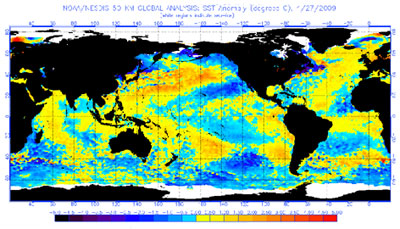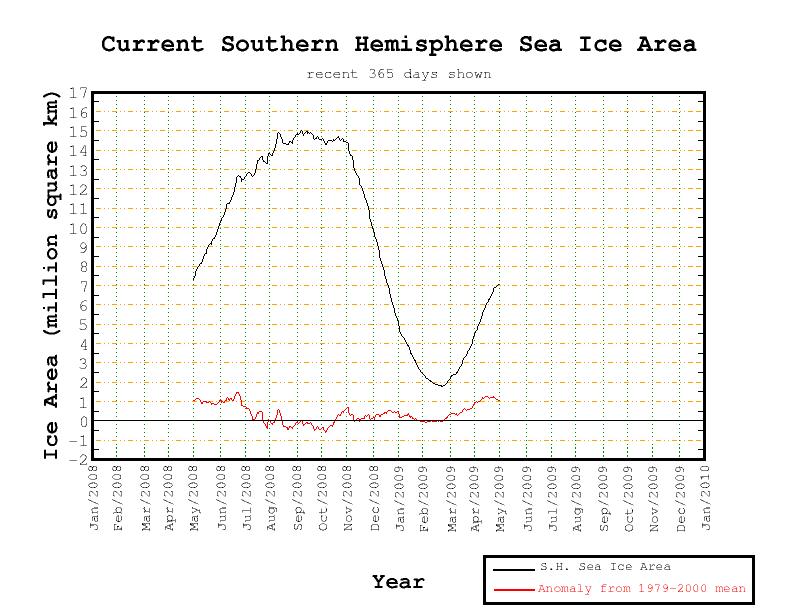Exactly one year ago, similar stories circulated, and if anything, they were more alarming. On March 25th, 2008, the BBC reported "Antarctic Ice Hangs by a Thread," a result, they stated, of "unprecedented global warming." But these reports, both last year and this year, are talking about the same ice shelf - the Wilkins Ice Shelf, an insignificant bit of floating ice that is located on the northern tip of the Antarctic Peninsula. Didn't it break up last year? How many times do we recycle the alarm over the seasonal melting of the same few thousand square miles of floating ice (ice that floats cannot contribute to sea level rise), off a continent that exceeds five million square miles in area?
Apparently over and over. An excellent analysis posted on April 17th, 2009 by Ron de Haan entitled "The Antarctic Wilkins Ice Shelf Collapse: Media recycles photos and storylines from previous years," documents how the Wilkins Ice Shelf has been reported by the mainstream media to be ominously collapsing every year now since 1999. Haan also provides satellite photography back as far as 1993 showing the end-of-summer thaws and mid-winter maximums for the Wilkins Ice Shelf. Not much has changed over the past 15 years. Thank goodness for the blogosphere to help us accurately assess the cryosphere!
The assumption in all these stories that report on the Wilkins Ice Shelf, and other melting ice around the Antarctic Peninsula, is that global warming is the cause, and that they are representative of a general melt occurring throughout Antarctica. And if this were true, this would be alarming, since 90% of the world's land based ice is in Antarctica. So is the ocean warming around Antarctica, and is Antarctica's overall total mass decreasing?

Antarctica are mostly colder than average.
The answer to both of these questions is almost certainly no. As this recent imagery from NOAA indicates, the southern ocean is actually colder than average. Except for a few areas directly south of the Indian Ocean, and in the area south of Patagonia and surrounding the Antarctic Peninsula, the rest of the ocean surrounding Antarctica - virtually all of the South Pacific and South Atlantic - is cooler than average. This data indicates no reason to believe ocean temperatures are causing overall loss of ice mass in the Antarctic; with the exception of the insignificant quantity of ice on the Antarctic Peninsula, they suggest the opposite.

What about the ice mass of Antarctica? Along with land based ice, which can raise sea levels when melted into the ocean, another significant indicator of polar temperature is the extent of floating sea ice. As the above table prepared by researchers at the University of Illinois indicates, the actual sea ice surrounding Antarctica is well above average. The black line represents the last 12 months of sea ice area, based on satellite data. You can see the sea ice reached a peak of 15 million square kilometers around September, during the peak of the southern winter. You can see it dropped to a low of 2 million square kilometers in mid-February, at the height of the southern summer. Currently the sea ice surrounding Antarctica is 7 million square kilometers and rising. The red line, however, is what is significant, because the red line indicates whether or not the sea ice is above or below the historical norm. And as you can see, as of May 2009, Antarctic sea ice is about 1.0 million square kilometers above normal.
Just like last year, to assist in the research for this post I contacted Dr. Roger Pielke Sr., a climatologist at the University of Colorado whose blog www.climatesci.org is one of the most balanced forums and respected sources of technical information on global climate anywhere. In response to my inquiry, he wrote the following: "The sea ice around the continent is far above average (ref. UIUC). Also, note the colder than average sea surface temperatures around Antarctic (ref. NOAA). If the media is going to discuss the Wilkens Ice Shelf, they should also discuss this other data. The expansion of the sea ice coverage implies a cooling."



Reader Comments
to our Newsletter